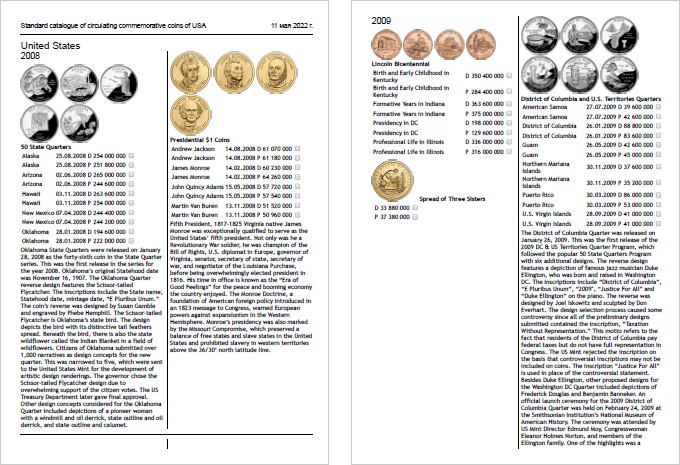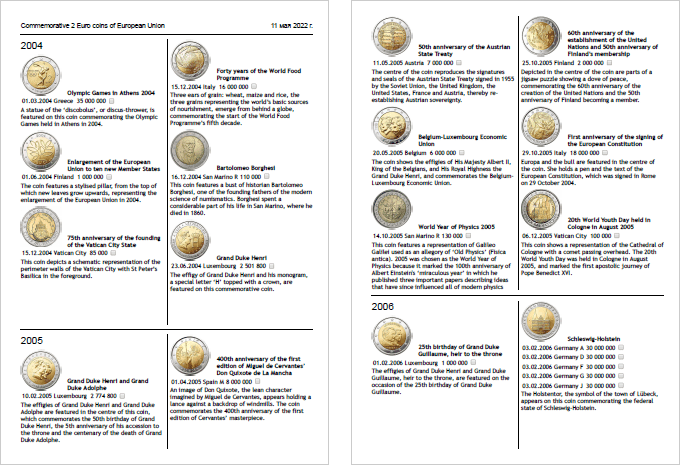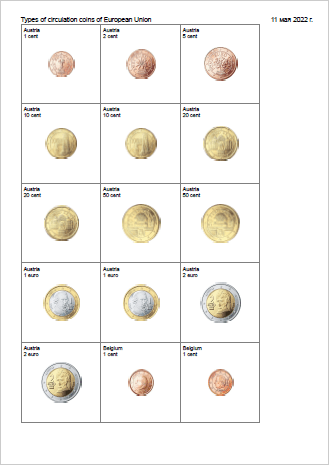Benutzerhandbuch
1 Einleitung2 Übersicht
3 Münzen eintragen
4 Münzen anzeigen
5 Eine Sammlung verwalten
6 Berichte
7 Referenz
8 Einstellungen
9 Bildeditor
1 Einleitung
1.1 Beschreibung
OpenNumismat ist ein handliches und zuverlässiges Programm für Münzliebhaber - erfahrene Numismatiker oder Neueinsteiger - die das Ziel haben, ihre Sammlung zu dokumentieren.
OpenNumismat versetzt Sie in die Lage, ihren eigenen Münzkatalog herzustellen, die Einträge zu organisieren und zu verwalten und jeden Eintrag mit einer detaillierten Beschreibung sowie mit Fotos zu versehen.
OpenNumismat wird absolut kostenlos vertrieben. Der Quellcode ist unter GPL-3.0 lizenziert und bei GitHub verfügbar.
Die offizielle Website ist verfügbar unter http://opennumismat.github.io.
1.2 Merkmale der Implementierung
OpenNumismat basiert auf der PySide6-Bibliothek mit der SQLite-Datenbank-Engine zur Speicherung der gesammelten Daten, was eine schlanke und reaktionsschnelle Benutzeroberfläche sowie Plattformunabhängigkeit ermöglicht.
Eine vollständige Liste der verwendeten Komponenten und Bibliotheken ist unter verfügbar
Die verwendeten Icons basieren auf dem LED Icon Set v1.0, Soft Scraps Icons von deleket und Flag icons.
Übersetzungen der Oberfläche werden von Fans via Transifex bereitgestellt. Vielen Dank für die Hilfe!
1.3 Lizenz
OpenNumismat ist OpenSource Software: Du kannst sie verteilen und/oder modifizieren, solange du die Bedingungen der GNU General Public Licence, veröffentlicht durch die Free Software Foundation, Version 3 oder (nach eigenem Ermessen) jeder späteren Version einhältst.
OpenNumismat wird in der Hoffnung veröffentlicht, dass es nützlich ist, aber OHNE IRGENDEINE GARANTIE, sogar ohne die implizierte Garantie der TAUGLICHKEIT oder EIGNUNG FÜR EINEN BESTIMMTEN ZWECK. Für weitere Details lesen Sie bitte die GNU General Public Lizenz.
Sie sollten eine Kopie der GNU General Public Lizenz zusammen mit OpenNumismat erhalten haben. Wenn nicht, lesen Sie diese bitte auf http://www.gnu.org/licenses/ nach.
2 Allgemeine Ansicht
Beim ersten Start öffnet sich das Hauptfenster mit einer Demo-Sammlung:

Das Hauptfenster besteht aus den folgenden Elementen:
- Münztabelle
- Bildbereich
- Verzeichnisbaum
- Infobereich
Wenn Sie eine beliebige Münze in der Münztabelle anklicken, werden detaillierte Informationen angezeigt: Im Bildbereich werden Münzfotos angezeigt, der Verzeichnisbaum wird bis zu der entsprechenden Münze aufgeklappt und der Infobereich zeigt alle eingegebenen Münzdetails.
Sie können eine neue leere Sammlung erstellen oder eine Demosammlung durch Eingabe neuer Daten verändern.
2.1 Übersicht der Münzen
Sie können die Ansicht der Münztabelle über das Menü Ansicht->Ansicht ändern ändern.
![]()
![]()
2.2 Detailbereich
Sie können das Info-Panel über das Menü Ansehen->Details>Infobereich erreichen
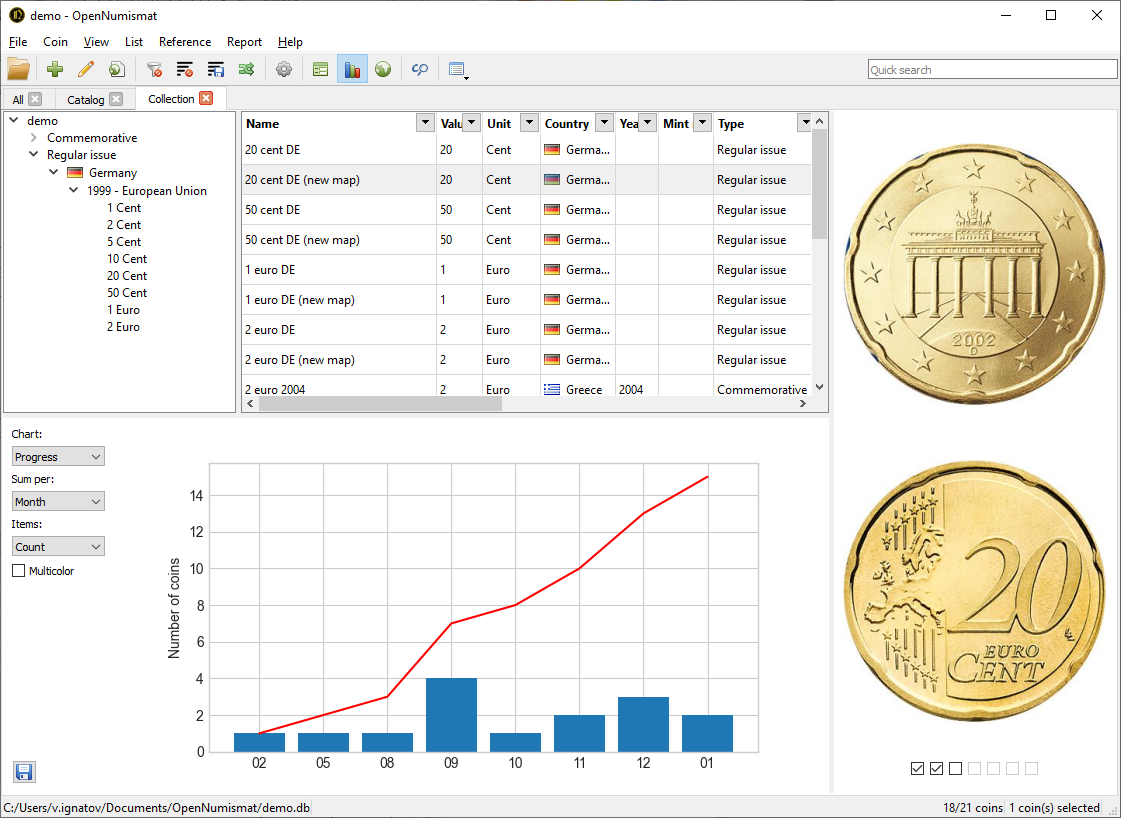

3 Münzeingabe
3.1 Eine Münze hinzufügen
Verwalten Sie Ihre Sammlung indem sie Einträge über alle gekauften, verkauften oder gesuchten Münzen machen.
Um eine neue Münze hinzuzufügen, wählen Sie das Menü Datensatz->Hinzufügen oder drücken Sie die einf -Taste. Anschließend öffnet sich der Bearbeitungsdialog.

Der Bearbeitungsdialog enthält 7 Registerkarten mit folgenden Feldern:
- Übersicht – Wichtigste Details:
- Kategorie – Art des Sammlerstücks;
- Name - ein aussagekräftiger Name für die Münze (der Name kann automatisch aus den übrigen Feldern erstellt werden, indem man die "Generieren"-Schaltfläche drückt);
- Region;
- Land;
- Periode – ein Abschnitt in der Geschichte des Landes oder eine Münzperiode
- Herausgeber
- Herrscher;
- Wert;
- Einheit;
- Jahr - gregorianisches Jahr
- Jahr auf Münze
- Prägestätte;
- Münzzeichen - ein Zeichen der Prägestätte;
- Typ;
- Serie - eine Serie von Gedenkmünzen;
- Thema - ein Ereignis oder Objekt, dem eine Gedenkmünze gewidmet ist.
- Übersicht - Zustand (Zustand der Münze aus der Sammlung)
- Status – das Hauptmerkmal, das die Zugehörigkeit einer Münze zur Sammlung bestimmt. Der Münzstatus beeinflusst die Verfügbarkeit und den Inhalt des Markt-Reiters. Verfügbare Werte
(können in den Einstellungen umbenannt werden):
 Demo – ein Objekt, das in der Sammlung weder vorhanden, oder benötigt wird;
Demo – ein Objekt, das in der Sammlung weder vorhanden, oder benötigt wird;
 Gebot – ein Artikel, auf den gerade geboten wird;
Gebot – ein Artikel, auf den gerade geboten wird;
 Bestellt – ein bestelltes Objekt;
Bestellt – ein bestelltes Objekt;
 Im Besitz – ein Objekt, das sich in der Sammlung befindet;
Im Besitz – ein Objekt, das sich in der Sammlung befindet;
 Duplikat – Kopie oder Ersatzstück aus der Sammlung;
Duplikat – Kopie oder Ersatzstück aus der Sammlung;
 Ersatz – ein Artikel, der gegen einen besseren Artikel ausgetauscht werden soll;
Ersatz – ein Artikel, der gegen einen besseren Artikel ausgetauscht werden soll;
 Verkauft - Artikel, der bereits verkauft wurde;
Verkauft - Artikel, der bereits verkauft wurde;
 Wunsch – ein Objekt, das man kaufen möchte;
Wunsch – ein Objekt, das man kaufen möchte;
 Verkauf – ein Artikel, der zum Verkauf angeboten wird;
Verkauf – ein Artikel, der zum Verkauf angeboten wird;
 Fehlt – ein Objekt, das in der Sammlung fehlt (gestohlen oder verloren gegangen);
Fehlt – ein Objekt, das in der Sammlung fehlt (gestohlen oder verloren gegangen);
 Beobachtet – Objekt, das in einer Auktion oder einem Geschäft beobachtet wird.
Beobachtet – Objekt, das in einer Auktion oder einem Geschäft beobachtet wird. - Zustand - Grad der Abnutzung;
- Menge - Die Anzahl von Doubletten oder Münzen in der Rolle;
- Format - Ausgabeformat (Einzelmünze, Set oder Rolle)
- Zustand;
- Platz – ein Platz für die Münze im Aufbewahrungsfach
- Lagerort – eine Beschreibung des physischen Aufbewahrungsortes der Münze
- Barcode;
- Bewerter
- Defekt – eine Beschreibung des in der Münzprägeanstalt entstandenen Fehlers
- Eigenschaften der Münze.
- Status – das Hauptmerkmal, das die Zugehörigkeit einer Münze zur Sammlung bestimmt. Der Münzstatus beeinflusst die Verfügbarkeit und den Inhalt des Markt-Reiters. Verfügbare Werte
(können in den Einstellungen umbenannt werden):
- Markt - Kauf:
- Datum;
- Preis;
- Bezahlt – Endpreis inklusive Provision;
- Provision – zusätzliche Kosten im Zusammenhang mit dem Erwerb einer Münze (Auktionsgebühr und/oder Versandkosten). Es ist möglich, die Höhe der Provision sowie den Prozentsatz des Preises (z. B. 10 %) einzugeben. Das Feld ist nur im Bearbeitungsfenster der Münze verfügbar;
- Verkäufer;
- Handelsplatz
- Rechnung – Link zum Rechnungsdokument auf der Festplatte oder URL;
- Info.
- Markt - Verkauf:
- Datum;
- Preis;
- Kaution – der insgesamt erhaltene Betrag unter Berücksichtigung der Provision;
- Provision – zusätzliche Kosten im Zusammenhang mit dem Erwerb einer Münze (Auktionsgebühr und/oder Versandkosten). Es ist möglich, die Höhe der Provision sowie den Prozentsatz des Preises (z. B. 10 %) einzugeben. Das Feld ist nur im Bearbeitungsfenster der Münze verfügbar;
- Käufer;
- Handelsplatz
- Rechnung – Link zum Rechnungsdokument auf der Festplatte oder URL;
- Info.
- Karte
- Adresse;
- Breitengrad;
- Längengrad;
- Technische Daten - Parameter (physikalische Parameter der Münze):
- Zusammensetzung;
- Material;
- Material 2;
- Feingehalt;
- Gewicht;
- Durchmesser;
- Stärke;
- Breite;
- Höhe;
- Form;
- Obv/Rev – das Verhältnis von Vorderseite zu Rückseite (Medaille, Münze).
- Technische Daten - Spezifik:
- Durchmesser - tatsächlicher Münzdurchmesser;
- Gewicht – tatsächliches Münzgewicht;
- Prägeachse – beschreibt, wie die Vorder- und Rückseitenstempel beim Prägen der Münze zueinander ausgerichtet waren. Meist in Grad angegeben, kann aber auch als Zifferblatt in Stunden ausgedrückt werden;
- Änderung.
- Technische Daten – Prägung (Daten zur Münzveröffentlichung):
- Ausgabedatum;
- Auflage;
- Ausgabezeitraum;
- Qualität - Prägetechnik;
- Bemerkung.
- Design (Beschreibung des Münzdesigns):
- Avers - Abbildung der Aversseite;
- Design (Avers);
- Designer (Avers);
- Graveur (Avers);
- Farbe (Avers);
- Rückseite - Das rückseitige Bild;
- Design (Revers);
- Designer (Revers);
- Graveur (Revers);
- Farbe (Revers);
- Rand – das Bild des Randes oder der Unterschrift auf der Banknote;
- Typ – Art des Münzrandes oder Titel des Banknotenunterzeichners;
- Etikett – Beschriftung am Münzrand oder Name des Unterzeichners der Banknote;
- Unterschrift – das Bild der Unterschrift auf der Banknote;
- Typ – Art des Münzrandes oder Titel des Banknotenunterzeichners;
- Unterschrift – Name des Unterzeichners der Banknote;
- Thema – eine Beschreibung des Themas oder Ereignisses, dem die Münze oder das Design gewidmet ist;
- Einstufung:
- 1#, 2#, 3#, 4# - Nummern einer Münzversion in den Katalogen;
- Seltenheit;
- Fine - der ungefähre Preis einer Münze im Status F-12, F-15;
- VF – der ungefähre Preis einer Münze im Erhaltungsgrad VF-20, VF-25, VF-30, VF-35;
- XF - der ungefähre Preis einer Münze im Zustand EF-40, XF-45;
- Unc – der ungefähre Preis einer Münze im Erhaltungsgrad MS-60 und höher;
- Variante, Vorderseite, Rückseite, Rand – eine kurze Beschreibung der Variante der Münze, ihrer Vorderseite, Rückseite und ihres Randes;
- URL - Weblink zu Informationen über die Münze oder zu einer Datei auf einem Datenträger
- Abbildungen:
- Foto 1, Foto 2, Foto 3, Foto 4, Foto 5, Foto 6 – 6 weitere Fotos oder Bilder. Sie können einem Bild einen individuellen Titel geben, indem Sie auf den Bildtitel doppelklicken oder mit der rechten Maustaste auf das Bild klicken.
- System (nicht änderbar, kann nur in der Münztabelle angezeigt werden):
- ID - Eindeutige Nummer der Münze in der Sammlung;
- Position – Standard-Sortierreihenfolge in der Münztabelle;
- Erstellt – Datum, an dem die Münze hinzugefügt wurde;
- Aktualisiert – das Datum der letzten Bearbeitung der Münze;
- Bild – ein optimiertes Bild der Vorder- und Rückseite der Münze zur Ausgabe in der Münztabelle.
Für manche Felder können Werte aus Auswahllisten gewählt werden (siehe 7):
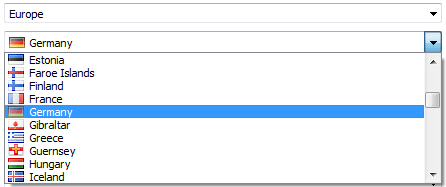
Im Einstellungen Dialog können nicht genutzte Felder entfernt werden (siehe 8):
Einige Felder (wie Wert, Jahr, Menge, Preis, Feingehalt, Gewicht, Durchmesser, Auflage) dürfen nur numerische Werte enthalten. Die Eingabe erweiterter Informationen in diese Felder ("v.Chr." im Feld Jahr, Bruchteile im Feld Wert, ein Gewichtsbereich im Feld Gewicht, usw.) kann im Dialog Einstellungen im Feld Freies Format in numerischen Feldern ermöglicht werden.
In Textfeldern (z. B. Thema, Eigenschaften, Beschreibung, Anmerkung) werden Hyperlinks unterstützt:

3.1.1 Bilder bearbeiten
Die Anwendung unterstützt bis zu 11 Bilder jeder Münze.
The following image formats are supported: BMP, GIF, JPEG, PNG, TIFF, WEBP. Images are saved in WebP format with transparency. Large images are compressed so that the maximum side does not exceed 1024 pixels (you can change it in the Settings dialog).
To insert or change an image, right-click on the field and select one of the drop-down menu items:
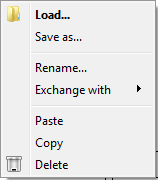
- Lade... - Bilddatei von Datenträger auswählen
- Speichern unter... - Bild auf Datenträger speichern;
- Umbenennen... - Legen Sie einen eindeutigen Namen für das Bild fest, der in der QuickInfo des Bildbedienfelds angezeigt wird (siehe 4.2);
- Tausche mit - Vertauscht zwei Bilder;
- Einfügen - fügt ein Bild aus der Zwischenablage ein (möglich sind eine Bilddatei, ein Bild aus einem Bildbearbeitungsprogramm oder ein Hyperlink);
- Kopieren - Kopiert das Bild für eine spätere Bearbeitung in die Zwischenablage;
- Löschen - Löscht das aktuelle Bild.
Durch Doppelklicken auf das Bildfeld wird das Dateiauswahlfenster geöffnet, falls das Bild noch nicht installiert ist. Andernfalls wird das Bild im Bildeditor (siehe 9) oder im Standard-Bildbetrachter Ihres Betriebssystems geöffnet.
Das Bild in der Tabelle wird automatisch aus den Bildern von Avers und Revers erstellt.
3.2 Eine Münze bearbeiten
Um die Münzdaten zu bearbeiten, müssen Sie auf die gewünschte Münze doppelklicken, mit der rechten Maustaste darauf klicken und „Bearbeiten“ auswählen. Bearbeiten..., Wählen Sie die Münze aus und drücken Sie die Eingabetaste oder wählen Sie die Münze im Menü Datensatz->Bearbeiten... aus. Anschließend wird der Bearbeitungsdialog geöffnet, der in Abschnitt 3.1 beschrieben ist.
3.3 Münzen duplizieren
Um schnell eine ähnliche Münze hinzuzufügen, kann man die Klonmethode benutzen. Dies geschieht mit einem Rechtsklick auf eine bestimmte Münze und der Auswahl Klonen. Es öffnet sich das vorausgefüllte Editieren Fenster. Jetzt kann man die gewünschten Felder ändern und speichern.
Sie können auch (mit Strg + Einfg oder Strg + C) die existierende Münze kopieren und (durch drücken von Shift + Einfg oder Strg + V) - einfügen. Der Bearbeitungsdialog wird ebenfalls geöffnet.
Eine kopierte Münze oder Münzgruppe (siehe unten) kann in eine Drittanbieteranwendung (z. B. MS Excel oder Notepad) eingefügt werden. Beim Einfügen in eine Drittanbieteranwendung werden dabei nur die Textfelder (ohne Bilder) kopiert.
Sie können auch eine neue Münze mit vorausgefüllten Feldern aus der Baumstruktur hinzufügen. Klicken Sie dazu mit der rechten Maustaste auf das Baumelement und wählen Sie „Münze hinzufügen“. Neue Münze hinzufügen.... Im geöffneten Bearbeitungsdialog werden alle gemeinsamen Felder für Münzen, die diesem Element entsprechen, ausgefüllt.
3.4 Mehrere Münzen gleichzeitig bearbeiten
Manchmal müssen Sie einige Felder gleichzeitig für mehrere Münzen ändern. Wählen Sie dazu die gewünschten Münzen aus (um mehrere Münzen auszuwählen, halten Sie die Shift oder Strg Taste gedrückt, um alle Münzen auszuwählen, drücken Sie Strg + A), drücken Sie die rechte Maustaste auf der Auswahl und wählen Sie Mehrfachbearbeitung... oder Datensatz->Bearbeiten... im Menü.
Im geöffneten Bearbeitungsdialog werden alle übereinstimmenden Felder für die ausgewählte Münzgruppe ausgefüllt. Jedes Feld verfügt über ein Kontrollkästchen, mit dem sich festlegen lässt, ob der Feldwert beim Speichern auf die gesamte Münzgruppe angewendet werden soll.
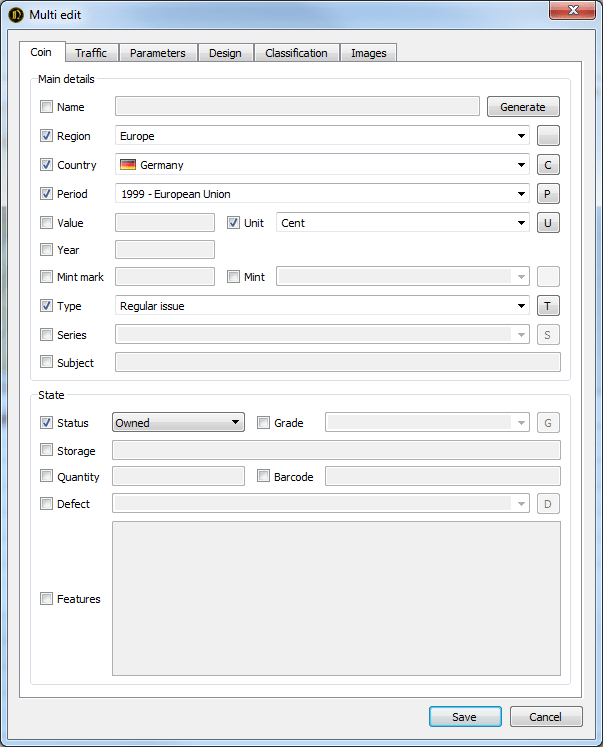
Außerdem ist die Gruppenbearbeitung über die Baumstruktur möglich – klicken Sie mit der rechten Maustaste auf das Baumelement und wählen Sie Münzen bearbeiten....
3.5 Löschen
Sie können Münzen einzeln oder als Gruppe aus der Sammlung entfernen. Zum Löschen wählen Sie im Menü Datensatz->Löschen, klicken Sie mit der rechten Maustaste auf die gewünschte Münze oder Münzgruppe und wählen Sie Löschen oder drücken Sie die Entf-Taste.
Entfernte Münzen werden sofort aus der Sammlung gelöscht und können nicht mehr wiederhergestellt werden - Vorsicht.
4 Münzen ansehen
4.1 Münztabelle
Die Münztabelle ist das zentrale Element der Anwendung und dient dazu, Münzdaten entsprechend den in den Einstellungen ausgewählten anzuzeigen.
Die Anzahl und Position der Felder kann im MenüListe->Spalten auswählen...oder indem Sie mit der rechten Maustaste auf die Tabellenüberschrift klicken und Spalten auswählen... festgelegt werden.

Im geöffneten Dialogfeld müssen Sie die gewünschten Felder markieren. Durch Ziehen der Feldnamen mit der Maus können Sie die Position der Felder zueinander ändern. Sie können Feldüberschriften auch direkt in die Münztabelle ziehen. Ein Klick auf die Feldüberschrift sortiert die Tabelle nach dem ausgewählten Feld.
Sie können die Breite einer Spalte in einer Tabelle anpassen, indem Sie den Rahmen der Spaltenüberschrift mit der Maus vergrößern oder indem Sie mit der rechten Maustaste auf die Überschrift klicken und Größe anpassen auswählen.
4.2 Bildbereich
Dieses Bedienfeld zeigt Bilder an, die mit dem Objekt verknüpft sind. Am unteren Rand befinden sich Kontrollkästchen, mit denen Sie die Anzahl der gleichzeitig angezeigten Bilder festlegen können.
Ein Doppelklick öffnet das Bild im Bildeditor (siehe 9) oder im Standard-Bildbetrachter Ihres Betriebssystems. Wenn Sie den Mauszeiger über ein Bild bewegen, wird dessen eindeutiger Name angezeigt, sofern dieser beim Bearbeiten des Objektes angegeben wurde.
4.3 Filter
Mithilfe des Menüs in den Spaltenüberschriften der Tabelle können Sie die Münzen nach den Werten der Felder filtern.

Das Filtermenü enthält alle Spaltenwerte. Markierte Werte werden angezeigt, die übrigen ausgeblendet. Um alle Elemente zu markieren oder die Markierungen aller Werte zu entfernen, wählen Sie (Alle). Am oberen Rand des Menüs befindet sich ein Feld, mit dem Sie die Menüwerte filtern können.
Um alle Filter in der aktuellen Liste zurückzusetzen, klicken Sie auf die Schaltfläche Alle Filter löschen in der Symbolleiste:

4.4 Verzeichnisbaum
Die Baumstruktur auf der linken Seite des Anwendungsfensters ermöglicht es Ihnen, Münzen nach Feldwerten zu gruppieren. Wenn Sie ein Baumelement auswählen, werden die Münzen, die dem ausgewählten Wert entsprechen, in der Tabelle angezeigt.
Um den Baum anzupassen, klicken Sie mit der rechten Maustaste auf das Baumelement und wählen Sie Baum anpassen...:

Im geöffneten Dialogfeld können Sie die Baumstruktur ändern, indem Sie die Elemente mit der Maus verschieben. Elemente, die von rechts nach links gezogen werden, werden am Ende des Baums hinzugefügt. Durch Ziehen von links nach rechts werden Elemente aus dem Baum entfernt. Um zwei Felder zusammenzuführen (z. B. Wert+Einheit), halten Sie beim Ziehen die Strg-Taste gedrückt.
4.5 Listen
Die Listen ermöglichen die Erstellung mehrerer unabhängiger Sammlungsansichten. Jede Liste speichert ihre eigenen Einstellungen für Felder, Spalten, Filter und die Struktur. Dadurch können die Listen als permanente Filter verwendet werden.
Sie können eine neue Liste hinzufügen, indem Sie auf das Menü Liste → Neu… klicken oder im Listenbereich (im leeren Bereich neben den Überschriften der vorhandenen Listen) doppelklicken und den Namen der neuen Liste eingeben. Alternativ können Sie eine Kopie der vorhandenen Liste erstellen, indem Sie mit der rechten Maustaste auf die Quellliste klicken und Klonen auswählen.
Sie können den Namen der Liste ändern, indem Sie das Menü Liste->Umbenennen... auswählen oder mit der rechten Maustaste auf den Listentitel klicken und Umbenennen... auswählen.
Geschlossene Listen werden nicht gelöscht und sind im Menü Liste->Öffnen verfügbar. Um private Listen endgültig zu löschen, wählen Sie im Menü Liste->Öffnen->Alle entfernen.
4.6 Statuszeile
Am unteren Rand des Anwendungsfensters befindet sich eine Statusleiste, die den Namen und Pfad zur Sammlungsdatei, die Gesamtzahl der Münzen in der Sammlung und in der aktuellen Münztabelle sowie die Anzahl der Münzen in der ausgewählten Gruppe anzeigt.

5 Umgang mit einer Sammlungsdatei
Die Sammlungsdatei ist eine normale Datei mit der Endung .db. In ihr sind alle Daten der Sammlung inklusive der Bilder mit Ausnahme der Bilder in den Auswahllisten gespeichert (siehe 7). Die Datei kann mit Hilfe des Betriebssystems kopiert, verschoben, gelöscht oder umbenannt werden.
5.1 Erstellen/Öffnen
Um eine neue Sammlung zu erstellen, wählen Sie im Menü Datei->Neu…. Im daraufhin geöffneten Dialogfeld wählen Sie den Speicherort und den Namen der neuen Sammlungsdatei aus.
Um eine bestehende Sammlungsdatei zu öffnen, wählen Sie im Menü Datei->Öffnen... und anschließend die gewünschte Datei aus. Sie können Sammlungsdateien auch verknüpfen (z. B. durch Auswahl der entsprechenden Option bei der Installation der Anwendung) und diese automatisch öffnen lassen, wenn Sie sie über den Dateimanager aufrufen.
Das Dateimenü zeigt bis zu 5 kürzlich geöffnete Sammlungen an, die Sie schnell öffnen können.
5.2 Sicherung
Um Datenverlust Ihrer Sammlung durch Hardware-, Software- oder menschliche Fehler sowie Schadprogramme zu verhindern, empfiehlt es sich, regelmäßig eine Datensicherung durchzuführen. Wählen Sie dazu im Menü Datei->Sicherung. Dadurch wird eine Kopie Ihrer Sammlung mit einem Zeitstempel (z. B. demo_171025115112.db für die am 25.10.2017 um 11:51:12 Uhr erstellte Kopie) im in den Einstellungen festgelegten Verzeichnis erstellt. Um die Daten wiederherzustellen, benennen Sie die Sicherungsdatei einfach um und entfernen Sie den Zeitstempel. Alternativ können Sie die Sammlungsdatei auch mit Ihrem Betriebssystem kopieren.
Hinweis: Es wird empfohlen, Backups auf einem anderen physischen Speichermedium als dem des Mitarbeiters zu speichern. Die Nutzung eines Cloud-Speichers wie Dropbox ist hierfür eine gute Option. Es ist außerdem wichtig, regelmäßig Backups zu erstellen, insbesondere vor oder nach umfangreichen Änderungen (siehe Abschnitt 8.4).
5.3 Komprimieren
Aufgrund der Besonderheiten der SQLite-Implementierung, die die Speicherung von Sammlungsdaten ermöglicht, wird der Speicherplatz nicht automatisch freigegeben, wenn Daten in der Sammlungsdatei gelöscht werden. Dies kann mit der Zeit zu einer Vergrößerung der Sammlungsdatei, deren Fragmentierung und einer Verlangsamung der Anwendung führen. Bei Bedarf können Sie die Größe der Sammlungsdatei reduzieren, indem Sie über das Menü Datei->Komprimieren unnötigen Speicherplatz freigeben.
5.4 Passwort
Im Menü Datei->Passwort festlegen... können Sie das Passwort festlegen, das jedes Mal abgefragt wird, wenn die Sammlung geöffnet wird.

Hinweis: Es findet keine Datenverschlüsselung statt, daher kann der Passwortschutz nicht als vollständig angesehen werden.
5.5 Synchronisation
Änderungen, die in mehreren Kopien einer Sammlungsdatei vorgenommen wurden, können sicher über das Menü Datei->Synchronisieren... zusammengeführt werden.
Die wichtigsten Eigenschaften des Synchronisationsalgorithmus:
- Alle neuen Einträge werden (erkennbar am Feld „Erstellt“) der geöffneten Sammlung hinzugefügt.
- Einträge mit gleichem Wert im Feld „ID“ und „Erstellt“ werden aktualisiert, wenn der Wert im Feld „Aktualisiert“ in der geöffneten Sammlung kleiner ist.
5.6 Importieren
OpenNumismat ermöglicht den Import von Daten aus Sammlungen, die in anderer Software (MS Excel, CoinManage, Collection Studio und Tellico) oder auf Websites (Colnect, Numista und uCoin.net) erstellt wurden.
Zum Importieren aus MS Excel wählen Sie im Menü Datei->Importieren->Excel und anschließend die Quelldatei aus. Danach öffnet sich der Dialog zum Zuweisen der ersten 10 Münzen aus der Quelldatei zu den Feldern.

6 Berichte
6.1 Berichte erstellen
Die Anwendung unterstützt die Erstellung von Berichten anhand von Vorlagen. Sie können bestehende Vorlagen bearbeiten oder eigene Berichtsvorlagen erstellen.
Der generierte Bericht kann über den Vorschau-Dialog gedruckt oder in den Formaten HTML, PDF und MS Word gespeichert werden.
Um einen Bericht zu erstellen, müssen Sie die Münzen auswählen, für die Daten im Bericht enthalten sein sollen, und den Vorschau-Dialog öffnen, indem Sie das Menü Bericht->Bericht... auswählen:
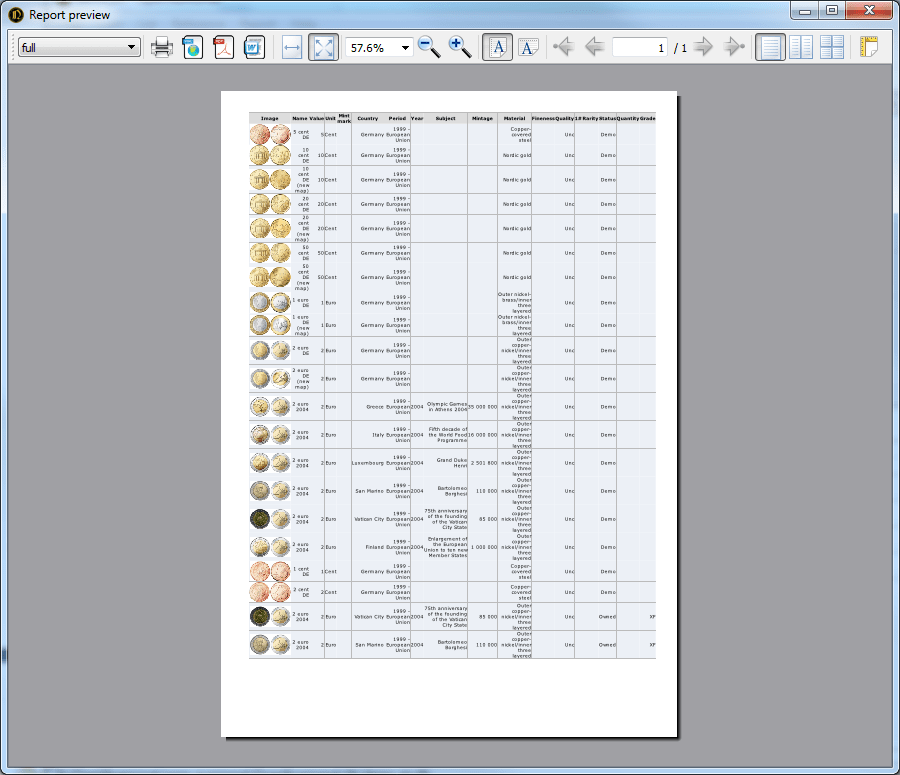
Im Vorschau-Dialog können Sie eine Berichtsvorlage auswählen (die linke Liste in der Symbolleiste), den Vorschaumodus steuern und den Bericht drucken oder in einer Datei des gewünschten Formats speichern (rechte Schaltflächen in der Symbolleiste).
Hinweis: Der Vorschau-Dialog verwendet eine ältere Bibliothek zur HTML-Generierung. Daher können Berichte in der Vorschau fehlerhaft sein und nicht der Darstellung in modernen Browsern entsprechen. Außerdem kann es bei der Generierung großer Berichte (mehr als 100 Münzen) zu Abstürzen kommen. Zum Anzeigen und Drucken können Sie den Schnellbericht (siehe 6.2) verwenden, um den Bericht in Ihrem Browser zu öffnen.
6.2 Kurzbericht
Durch Auswahl des Menüs Bericht->Im Browser anzeigen können Sie den Bericht für die ausgewählten Münzen schnell im HTML-Format anzeigen.

Für einen schnellen Bericht wurde die im Einstellungsdialog als Standardvorlage festgelegte Vorlage verwendet.
6.3 Bearbeitungsvorlagen
Die Engine zur Generierung von Berichtsvorlagen basiert auf der Open-Source-Bibliothek Jinja2.
Benutzervorlagen sollten im Ordner „Dokumente“ (üblicherweise C:\Benutzer\Benutzername\Dokumente\OpenNumismat\Vorlagen) abgelegt werden. Jede Vorlage befindet sich in einem separaten Unterordner, dessen Name als Vorlagenname verwendet wird.
Die Berichte werden in UTF-8-Kodierung erstellt, daher sollten auch die Vorlagen in derselben Kodierung vorliegen. Für die Bearbeitung der Vorlagen empfiehlt sich daher beispielsweise die Verwendung von Notepad++.
Achtung: Beim Löschen, Neuinstallieren oder Aktualisieren der Anwendung können Benutzervorlagen verloren gehen. Sichern Sie Ihre Vorlagen daher immer, bevor Sie Änderungen an der Anwendung vornehmen.
6.4 Beispiele für Berichtvorlagen
Commemoratives_ByCountry
Commemoratives_ByYear
holders
6.5 Exportieren der Münztabelle
Mit OpenNumismat können Sie die aktuelle Münztabelle mit allen angewendeten Filtern und Sortierungen in einer separaten Datei im MS Excel-, HTML- oder CSV-Format speichern (Hinweis: In der aktuellen Implementierung werden keine Bilder exportiert).
Sie können die Münztabelle über das Menü Bericht->Aktuelle Liste speichern… exportieren. Wählen Sie im sich öffnenden Dialogfeld den Dateinamen und das gewünschte Format aus und speichern Sie die Datei.
6.6 Statistiken
Sie können auch MS Excel verwenden, um Diagramme zu erstellen und Statistiken zu berechnen. Kopieren Sie die benötigten Münzen aus OpenNumismat nach MS Excel oder exportieren Sie eine Münztabelle in eine MS-Excel-Datei (siehe 6.5) und nutzen Sie deren Funktionen.
6.7 Zusammenfassung

7. Auswahllisten
Referenzen erleichtern die Dateneingabe beim Bearbeiten einer Münze und fügen der Datenanzeige Symbole (z. B. Flaggen) hinzu. Referenzen sind für folgende Felder verfügbar: Region, Land, Periode, Herrscher, Einheit, Prägestätte, Serie, Erhaltungsgrad, Material, Form, Qualität, Rand, Seltenheit, Vorderseite/Rückseite, Typ, Defekt, Ort (Kauf oder Verkauf).
Die Bearbeitung von Referenzen ist im Dialogfeld „Bearbeiten“ möglich:
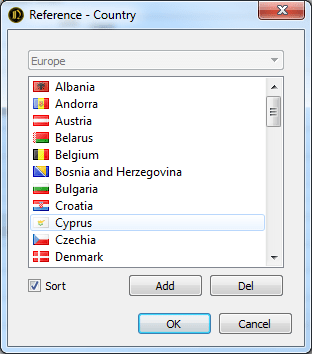
oder über das Menü Referenz->Bearbeiten...:

Ein Rechtsklick auf den Eintrag im Verzeichnis öffnet die Möglichkeit, das Symbol des Elements hinzuzufügen oder zu löschen:
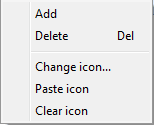
Die Verweise für Land, Periode, Herrscher, Einheit, Prägestätte und Serie sind Querverweise und können nur aktualisiert werden, wenn Sie den Wert des Basisfelds auswählen, das in dem Verweis vorhanden ist. Um beispielsweise eine neue Prägestätte hinzuzufügen, müssen Sie zuerst ein vorhandenes Land auswählen.
Das Kontrollkästchen Sortieren sortiert alle Einträge im Verzeichnis; andernfalls werden alle Elemente in der Reihenfolge angezeigt, in der sie eingegeben wurden.
Um schnell Referenzen mit eingegebenen Daten aus der Sammlung zu füllen, wählen Sie das Menü Referenz->Aus Sammlung füllen.
Standardmäßig werden Verweise in einer separaten Datei mit der Endung .ref gespeichert, die über Ihr Betriebssystem kopiert, umbenannt oder gelöscht werden kann. Der Pfad zur Verweisdatei kann im Einstellungsdialog festgelegt werden.
Sie können auch eine aktuelle Referenz an eine Sammlungsdatei anhängen. Wählen Sie dazu Referenz->Aktuelle Referenz anhängen oder Referenz->Aktuelle Referenz trennen, um eine Referenz aus der Sammlung zu entfernen und die Standardeinstellung aus den Einstellungen zu verwenden.
You can customize default reference with Reference generator.
8 Einstellungen
Im Dialogfeld „Einstellungen“ können Sie das Erscheinungsbild und das Verhalten der Anwendung konfigurieren. Um das Dialogfeld zu öffnen, wählen Sie im Menü Datei->Einstellungen:
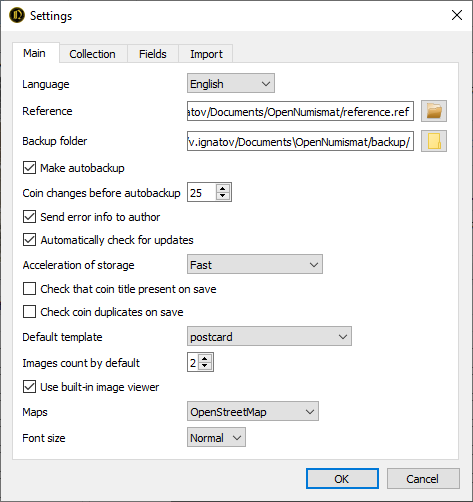
8.1 Felder
Im Bereich „Felder“ des Einstellungsdialogs können Sie Teile der Sammlungsfelder umbenennen und aus der Benutzeroberfläche entfernen. In diesem Fall werden nur die ausgewählten Felder in der Programmoberfläche angezeigt, die Daten aller Felder bleiben jedoch erhalten.
8.2 Geschwindigkeit des Speichervorgangs
Die SQLite-Datenbank-Engine verfügt über zahlreiche Einstellungen, die die Geschwindigkeit und Zuverlässigkeit beeinflussen:
- Zuverlässig – alle Änderungen werden garantiert gespeichert;
- Schnell - Änderungen können verloren gehen, wenn die Stromzufuhr während des Betriebs unterbrochen wird (für die meisten Fälle empfohlen);
- Besonders schnell (gefährlich) - empfohlen, wenn Sie eine große Anzahl von Änderungen vornehmen, vorausgesetzt, Sie erstellen vorher eine Datensicherung.
8.3 Anzahl der Bilder standardmässig ermitteln
Standardmäßig werden im Bildbereich Bilder gezählt.8.4 Automatische Sicherung
Sie können die automatische Datensicherung aktivieren. Diese Funktion erstellt nach jeder Änderung einer festgelegten Anzahl von Datensätzen eine Sicherungskopie.8.5 Sammlung
Sammlungsspezifische Einstellungen (für jede Sammlungsdatei gespeichert):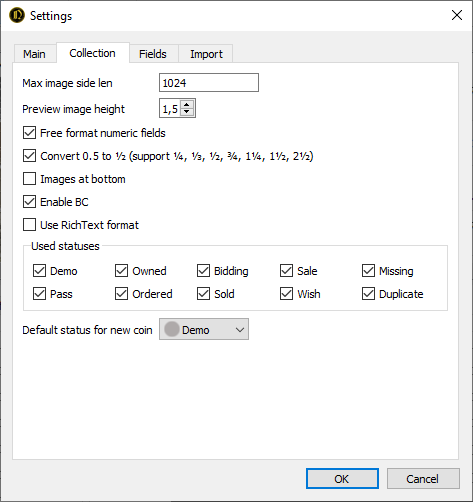
Vorschaugröße Bilder:
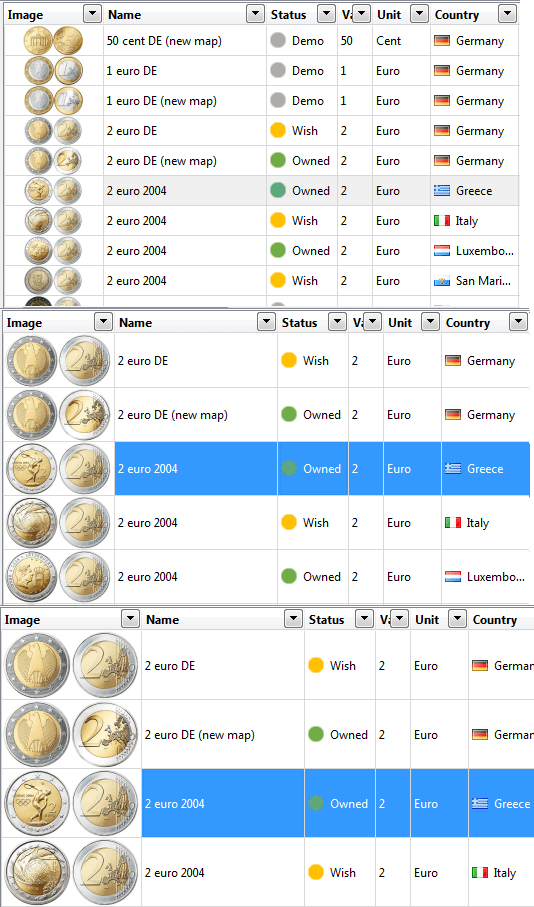
Freiformat-Zahlenfelder – zur Eingabe von Werten im erweiterten Format (Fragezeichen im Feld „Jahr“, Brüche im Feld „Nominal“, Bereich im Feld „Gewicht“ usw.).
Bilder unten:

9 Bildeditor
OpenNumismat verfügt über einen integrierten Bildeditor (Hauptprojekt ist https://github.com/OpenNumismat/ImageEditor), der über die Einstellungen aktiviert werden kann.
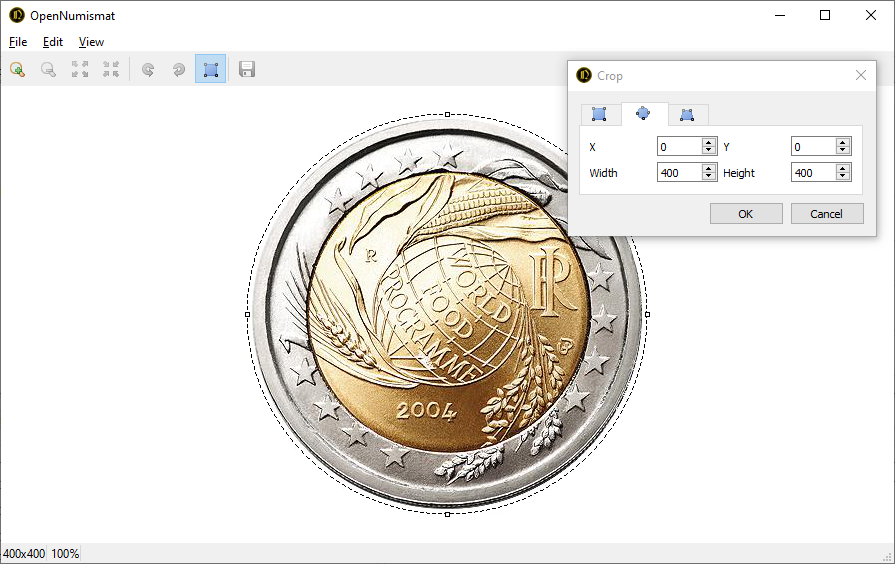
Eigenschaften der Münze
- Unterstützt gängige Bildformate: JPEG, PNG, BMP, TIFF, GIF, WebP
- Macht ein Foto mit der Webcam (für bessere Ergebnisse versuchen Sie Camo)
- Bildbearbeitungswerkzeuge: Größe ändern, drehen, zuschneiden (Rechteck, Ellipse, perspektivische Transformation)
- Hintergrund entfernen mit rembg
- Bis zu 10 Rückgängig-/Wiederherstellen-Aktionen
- Einmal klicken, um zwischen „Optimale Passform“ und „Tatsächliche Größe“ umzuschalten.
- Vollbildmodus
- Zoomen mit dem Mausrad
Tastenkombinationen
Ctrl + O — Open file
Ctrl + S — Save
Ctrl + C, Ctrl + Insert — Copy
Ctrl + V, Shift + Insert — Paste
Ctrl + Z — Undo
Ctrl + Y — Redo
Alt + ← — Rotate to left
Alt + → — Rotate to right
C — Open crop tool
R — Open rotate tool
B — Remove backgroud with AI
Ctrl + ← — Previous image
Ctrl + → — Next image
Ctrl + ↑ — Previous record
Ctrl + ↓ — Next record
+ — Zoom in
- — Zoom out
0 — Fit to window
1, A — Scale 100%
2 — Scale 200%
3 — Scale 300%
4 — Scale 400%
5 — Scale 500%
6 — Scale 600%
F11 — Full screen
Esc — Quit
Mausrad nach oben – Vergrößern
Mausrad nach unten – Verkleinern
Doppelklick mit der linken Maustaste – Vergrößern
Mittlere Maustaste drücken – Vergrößern
Doppelklick mit der rechten Maustaste – Verkleinern



